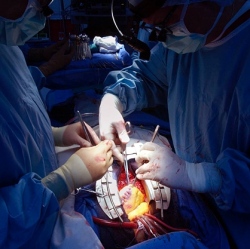
The "body on a chip" project replicates human cells to print structures which mimic the functions of the heart, liver, lung and blood vessels.
The organs are then placed on a microchip and connected with a blood substitute, allowing scientists to closely monitor specific treatments. The US Department of Defense has backed the new technology with $24m (£15m).
Bioprinting, a form of 3D printing which, in effect, creates human tissue, is not new. Nor is the idea of culturing 3D human tissue on a microchip.
But the tests being carried out at the Wake Forest Institute for Regenerative Medicine in North Carolina are the first to combine several organs on the same device, which then model the human response to chemical toxins or biologic agents.
The modified 3D printers, developed at Wake Forest, print human cells in hydrogel-based scaffolds.
The lab-engineered organs are then placed on a 2in (5cm) chip and linked together with a circulating blood substitute, similar to the type used in trauma surgery. The blood substitute keeps the cells alive and can be used to introduce chemical or biologic agents, as well as potential therapies, into the system.
